Archive for Travel / lifestyle musings
November 15, 2007 at 8:01 pm · Filed under Travel / lifestyle musings
Normally I’m an advocate of preserving our natural resources for future generations. This means protecting wilderness areas from undue encroachment, and setting in place reasonable policies for use and management of natural spaces. It turns out that here at Oceano Dunes a battle is ongoing for domination of the sand, with off-highway vehicle users and campers (like us) on one side, facing off against beachfront property owners.
I can’t jump into the middle of the battle without knowing better what the issues are. So far I’ve heard only from one side. But I can say that an experience like camping overnight on the sand at Oceano Dunes is almost unique in this country, and that opportunity is itself a form of vanishing resource.

It seems to do no harm for us to be here. We will pack out everything we bring in and leave no trace of our visit (except tracks in the sand). We won’t destroy dune grasses or harass wildlife, even the sand dollars that are embedded in the flat wet sand below the high tide line. I can think of no one, no living thing, and no local natural resource that we will negatively impact.
But I suppose those people who live near the beach have their reasons for wanting to get rid of us. And they may eventually win the battle, so the opportunity to camp by the sea here at Oceano ““ a unique experience in all of California ““ may be only temporary. It may join a long list of really special travel experiences that your parents or grandparents remember doing, but which are no longer allowed in the name of “property rights”, wildlife protection, or national security.
Some of those changes have been for good reasons, such as no longer feeding bears garbage at Yellowstone and Yosemite. But others have been pushed through for political gain or as part of shallowly-disguised land grabs. Regardless of the reason, we seem to have less freedom and fewer opportunities here year after year. If you want to experience what we’ve done here, I know of only two places left in the US (Oceano Dunes and South Padre Island). And in general, it’s a good idea to grab the experiences that the world still has to offer before they disappear.
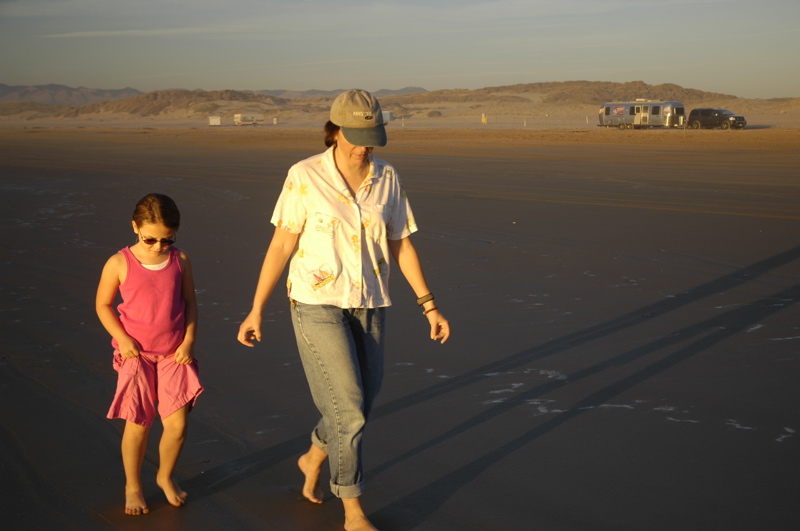
I would like to stay here a week, and next time we are in the area we will absolutely do that. The truck that drives by (several times a day, it turns out) has ice, water ($0.50 per gallon!), and pump-outs for $30. With two full tanks of propane and our solar panels, we can stay here for a long time. Better yet, I can work here, since my cell phone and cellular Internet connection function well. This may have been one of the best days at work I’ve ever enjoyed, with door wide open to admit the ocean breeze, the high tide now only fifty feet from our door, incredible sunshine, and Emma happily making a castle in the sand nearby.
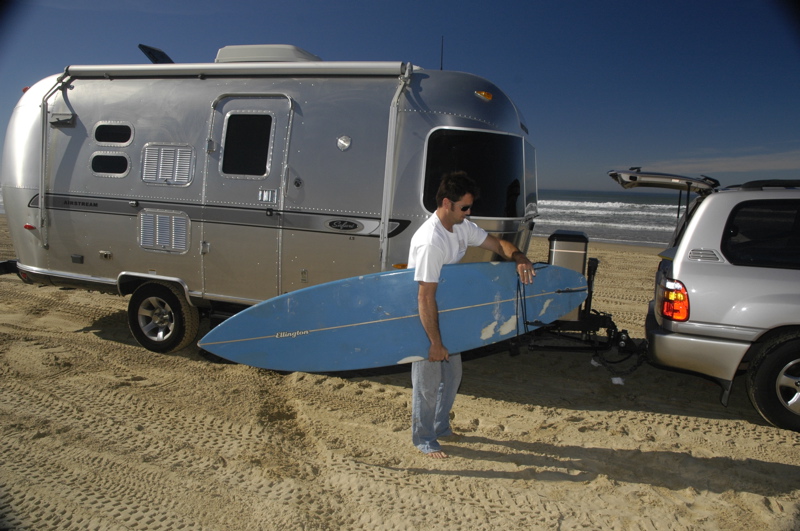 Around 10 this morning we had a visit from Shaun Kieran and his associate Nikolai, who work repairing church organs all over southern and central California. They pulled up in a new 20-foot Airstream Safari Special Edition, which they live in while working on jobs. On the weekends, Shaun brings his wife and two small children out in the Airstream for vacations.
Around 10 this morning we had a visit from Shaun Kieran and his associate Nikolai, who work repairing church organs all over southern and central California. They pulled up in a new 20-foot Airstream Safari Special Edition, which they live in while working on jobs. On the weekends, Shaun brings his wife and two small children out in the Airstream for vacations.
These guys were just looking for a spot to take a break in between jobs today and went looking for this beach. They were surprised to see us parked here on the sand, so they stopped and unloaded their surf boards and we got acquainted. The water was too cold for surfing even with their wetsuits, but Shaun will be back next weekend with the family for some camping.
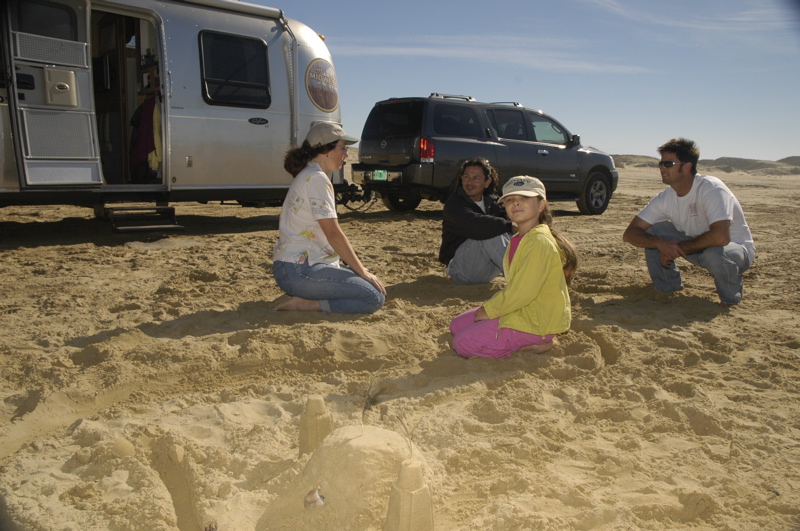
We hung around the beach until 3 p.m., and by then the sun was already dipping low to the southwest. It was time to head off to our next stop, down in Los Olivos with Cindy, Dennis, and Madison. But first, we stopped at the North Beach Campground to use the dump station, and there we had one more surprise. A fellow walked up to us and said, “Hey, you might not remember me, but we were parked with you in Whispering Pines in Vermont!” We love the “small world” moments like that.
November 13, 2007 at 8:52 pm · Filed under FAQs, Travel / lifestyle musings
As I travel I’ve been asked by friends to keep my eyes open for certain models of vintage Airstreams that are for sale. Out west I find some of the best Airstream hunting, because around any corner there can be a well-preserved vintage trailer sitting in a low-humidity climate, just waiting for someone to come by. California is not the best spot because prices here tend to be high, and only a little of the state is truly arid, but there are still plenty to be had.
Roger heard about a 1978 Airstream Excella 500, 31 feet long, sitting in a salvage yard not far from Visalia. After dropping off the Nissan for its expensive 60,000 mile service, we drove over to the yard to check out the trailer and document it for anyone who might be interested. Roger posted my photos and his on Flickr.
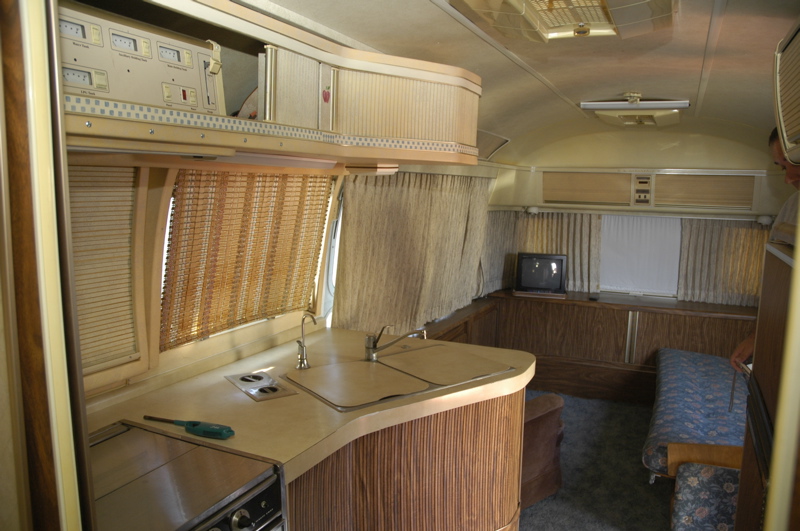 The seller is asking for $7,200 or best offer, which seems a tad high, but the trailer is very well kept. It was clearly loved by someone and maintained. The interior is all original except for fabrics, and it has a good roomy floorplan up front, twin beds amidships, and a spacious rear bath. The body is in good shape with no major dents.
The seller is asking for $7,200 or best offer, which seems a tad high, but the trailer is very well kept. It was clearly loved by someone and maintained. The interior is all original except for fabrics, and it has a good roomy floorplan up front, twin beds amidships, and a spacious rear bath. The body is in good shape with no major dents.
Like a lot of 1970s trailers, it has storage in abundance, tambour doors everywhere, extensive clearcoat peeling, tired axles, fogged Vista-View windows, and lots of potential. I’d expect to drop another $4-5k into it quickly for axles, brakes, tires, leak fixes (I’m sure there are leaks somewhere), new awning fabric, and a bit of floor rot repair near the entry door. A more complete restoration that repaired or replaced the fogged windows, replaced all the fabrics, and included a budget for appliance replacements would probably run $10-20k depending on how nice you wanted it. A full-blown restoration to get it perfect and polished … well, that could cost anything.
The point is that an Airstream can cost almost anything. You can certainly get going on a budget as low as $5k (we did). For a lot of people, the best course is to take an “OK” trailer like this one and upgrade it slowly as you use it. If I were looking for a longer trailer that I could start using right away, I’d consider this one with a working budget of about $10-12k for trailer and initial fixes.
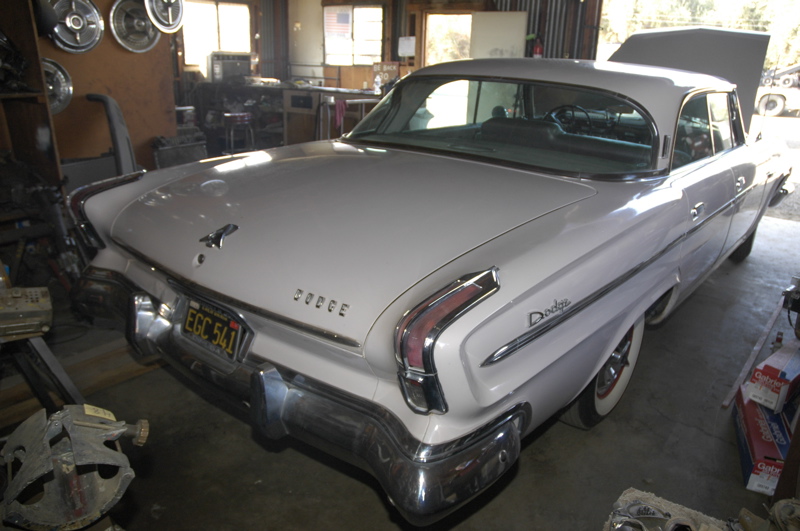 While we were poking around at the salvage yard we also spotted a very tired 1976 Airstream Caravanner 25 (needing a complete restoration and sporting some poorly repaired rear dome segments), and this “so ugly it’s cute” 1962 Dodge 880.
While we were poking around at the salvage yard we also spotted a very tired 1976 Airstream Caravanner 25 (needing a complete restoration and sporting some poorly repaired rear dome segments), and this “so ugly it’s cute” 1962 Dodge 880.
The Dodge is all original. It’s the classic story of the car owned by a little old lady and used only occasionally. 34,000 miles and it shows just a little patina in the form of small rust areas around the corners. It runs and the interior is excellent. I especially like the funky push-button transmission.
I’m intrigued by the idea of using a 1960s car as a tow vehicle for our 1968 Airstream Caravel, but I’m not buying this one yet. The seller wants $6,500 if you’re interested. Photos are also on Roger’s Flickr album.
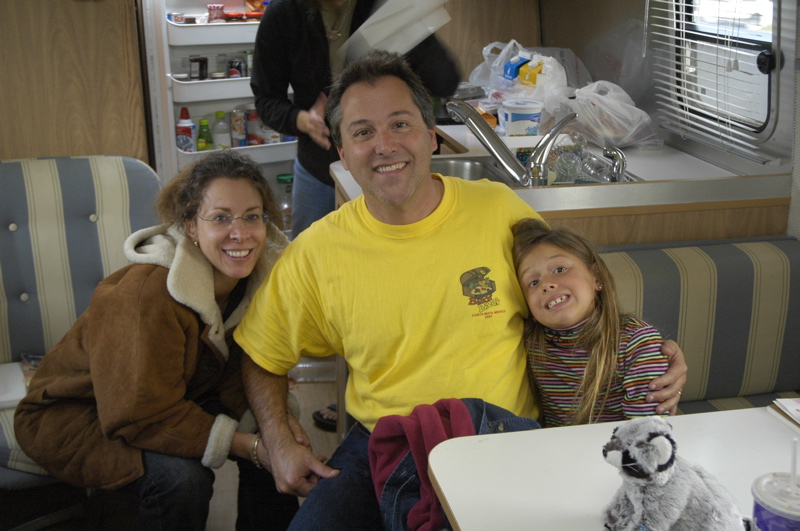
Tomorrow we are moving off. We have mooched a few very nice nights with Roger & Roxy, gotten our errands done, eaten coconut cream pie, and caught up mostly with business. It’s been fun and relaxing being here.
Now we’re heading to the coast to meet up with some Airstream folks who flagged us down a few days ago on our way out of Yosemite: Cynthia, Dennis, and 7-year-old Madison. They’ll courtesy park us at their house, so this is a a great low-cost week, but that’s not the reason we’re going there. It just looks like fun. Good enough reason.
November 12, 2007 at 12:07 am · Filed under Travel / lifestyle musings
One constant theme of this blog has been looking forward. We haven’t spent much time reminiscing. We are always looking to the next adventure, and trying to make the most of the moment. This is great most of the time, but now looking forward means we can see the end of the adventure coming — at least as it has been.
Eleanor and I have been conferring daily for weeks about our travels through next spring. We’ve finally come to some conclusions. First off, we will park the Airstream for about two and a half months, starting December 21, 2007. That’s the Big One.
There are a few good reasons for this. We need to get serious about feathering our nest in Tucson. One point of buying the house was to have a place to go to in case of emergency, or to catch up on things between trips. It needs painting, furniture, and a few details (like a kitchen) before we can inhabit it.
We want to get back before Christmas to finally meet our long-distance friend Bruno, who is flying in from France for his annual southwest US vacation. And we’d like to celebrate Christmas in the house, even if it means sitting on a rug on the floor and cooking in the Airstream.
It will take us most of two months to get the house in order. This schedule will allow us to scoot off for long weekends occasionally, so we won’t be totally housebound. We’re even planning to keep the Airstream plugged in, stocked, and with the fridge running, so we can grab a quick trip at any time. All of those trips, and some in-between ruminating, will be blogged. By mid-March, the house work should be done. At that point we’ll head out again for at least 6-7 months.
I wonder if, during the house phase, we’ll start looking back on the past two years wistfully. Will we start looking backwards? I’ve heard from other full-timers that the transition back to a fixed location can be a little rough.
Fortunately, for us this isn’t the end, only a transition. We are going to continue to travel extensively in the Airstream even after the house is done. There’s really no reason to settle down yet, and there are so many places we want to go. So the blog will continue.
The only question left is what to do with the blog during the transition period of Dec 21 through mid-March. Well, there’s good news in that department. We are working on a major new Airstream Life website which hopefully will be up by Christmas. I have invited several top-notch Airstream bloggers to join me at our new website, and we’ll all be blogging (in separate threads) here at Airstreamlife.com. So even if our blog is a little quiet, there will be 4-6 other similar blogs to follow.
I may also launch a temporary blog for the house renovations for those who want to snicker as we bumble through the process. I’m sure we’ll have a few amusing adventures of a different sort as we wrestle with contractors and write enormous checks for things we didn’t expect to need.
Hmm … let’s not dwell on that now. We have good stuff to think about in the coming few weeks. Southern California awaits, with all its fantastic spots: Palm Springs, Joshua Tree National Park, Anza-Borrego, San Diego, In’n’OutBurger … And, we have the inklings of a really great trip across Texas and into Mexico, and then to the southeast US this spring.
Going forward, our goal is to find a good balance between the benefits of travel and the benefits of a fixed home. I expect that challenge will be with us for many years. Just when we think we’ve got it figured out, something will happen to mix the formula up a bit. That’s good. Life is a process of constant change, and that’s what makes it interesting.
November 10, 2007 at 9:58 pm · Filed under Travel / lifestyle musings
After two years of full-time living and traveling in our Airstream, I think we have come to really understand what we are doing and make the most of it. Why is it that when we are in the groove we inevitably have a reason to break out of it?
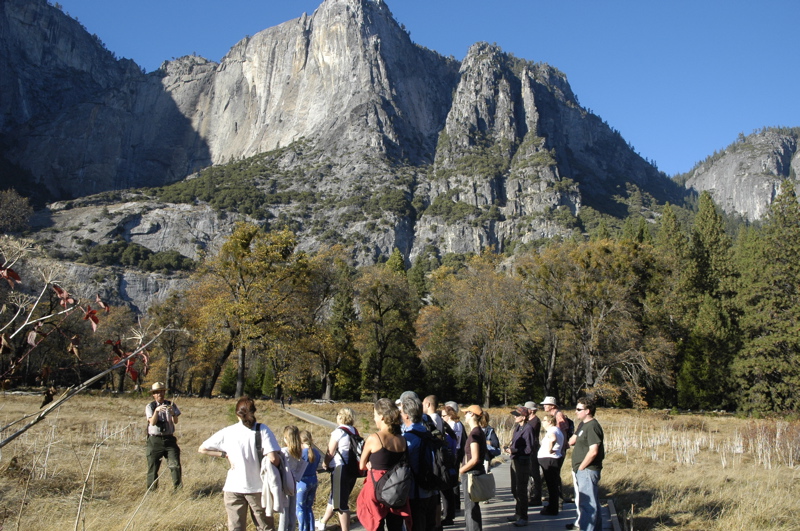
Friday morning we were all feeling fine. There was nothing much on our schedule except another 2 p.m. Ranger Walk (this time on park geology), and we had a sated feeling about the park that encouraged us to just hang around camp and have a relaxing morning. I asked Eleanor why she was looking so happy, and she said, “We’re just camping!” She meant we had no obligations, no pressing schedule, beautiful surroundings, endless opportunity, and all was well.
Many times we’ve been in a wonderful national park but I’ve had business obligations hanging over my head, worries about meeting deadlines, phone calls that needed to be returned, etc., and those things have tainted the enjoyment of the place. Finally this year the pressure of business seems to be abating, and I’m finding I’m more able to walk away from mental stress. The rest of the family can sense that, and I think that’s helping them relax as well.
In Yosemite I haven’t been free from the duties of my business but I have managed to compartmentalize them. I have allotted 60 minutes in the early morning to write before Emma is up, half an hour in the late afternoon in the center of the village to check voicemail and maybe briefly return a call, and an hour in the evening to respond to email at the hotel. It helps that the news from the business and from my friends has been uniformly good. The associates who help me run Airstream Life are all independent professionals who can generally take care of whatever comes up without my intervention, which is the way any good manager should want it.
In the afternoon Eleanor and I left Emma in the care of Robert and Kelli for a couple of hours so we could explore the Yosemite Museum (native baskets, an exhibit of climbing photos from 60s, obsidian arrowheads) and so Eleanor and I could visit the Ahwanee together. Sitting on the big couch by the fireplace is a romantic experience. I have to admit that the fireplace is one advantage of our house over the Airstream on a cool fall evening.
I’d like to come back in summer so we can hike to Half Dome (16 miles roundtrip), or perhaps do some backcountry camping in our tent. I did a little research on those possibilities for a future trip. But for now it is time to head south. This is the irony that I was alluding to earlier. The final days of our full-time travels are approaching quickly, and there’s much more we want to do before we pull into the carport in Arizona. I’ll talk about that in greater detail in a future blog entry.
Today we hitched up and moved south about 130 miles to Visalia, where we are courtesy parking at the home of blog readers Roger and Roxy. They’ve got a nice concrete pad next to their house and have generally rolled out the red carpet to us, with wifi, 30-amp electric, and water. They even moved their Airstream to the curb so we could park on the pad inside their fence. When an Airstreamer moves their own treasured trailer to the curb, it’s like offering their own bed, so we feel honored.
November 8, 2007 at 8:43 pm · Filed under Travel / lifestyle musings
We started off slow in Yosemite. On Wednesday morning I got up early and spent the entire morning dawdling over work rather than rushing out and hiking the park. This may seem like a cardinal sin in Yosemite, but I felt like getting some things cleaned up and I was taking advantage of the fact that Robert was running his generator. We’re plugged into it. Since Robert ran the generator for about four hours, we recharged at the rate of about 4 amps/hr and avoided draining the batteries in the morning when I was using the laptop and our furnace use was high.
I’ve found it’s better to avoid using power than to try to recoup it, because you use it far faster than you can recharge. It’s easy to consume 10-20 amps per hour with just a few lights and the furnace cycling on and off, but as I’ve pointed out before, the batteries will only recharge at a certain rate with a 2-stage charger no matter how big your generator is. So two hours of evening usage at 16 amps/hour will take about eight hours to get back with the generator!
I didn’t make the family sit inside while I fiddled with the computer, however. Emma and Allison are always off playing. Kelli and Robert headed off for a walk, and around 2 pm we all headed out for a Ranger program about wildlife in the park. We saw woodpeckers, deer, and red-tailed hawks, but Emma and Allison wanted to see a pika. They live only above the treeline. To see those elusive little critters we’d need to drive about an hour up to Tuolumne.
Yosemite Valley is really more of a small town rather than a quiet park site. It’s much more developed than many other national parks, but this concentrates the visitor impact in a relatively small area, leaving most of the park wild. There’s a great visitor center, theater, educational info, store, post office, etc in the village, and if I stand still I can even make a call once in a while — not that I want to.
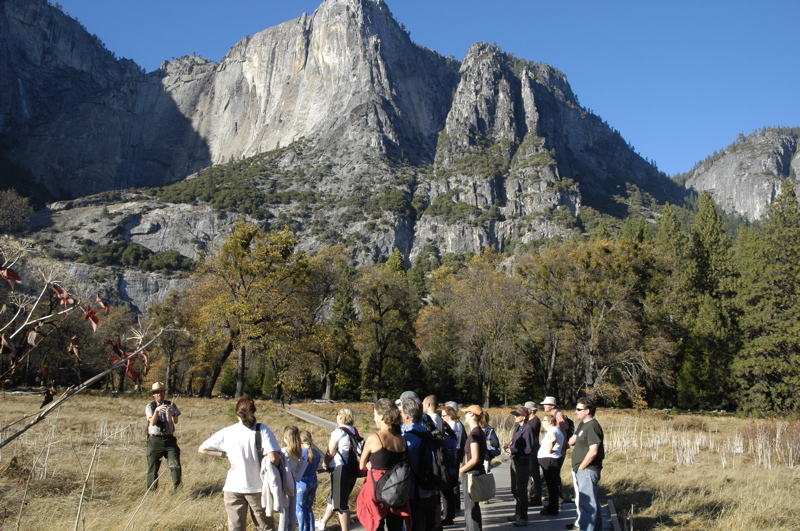
Photographically the village (and indeed, the entire park) is ideal. Stand near the meadow for great scenes in every direction. You don’t have to go far to find pictures in Yosemite.
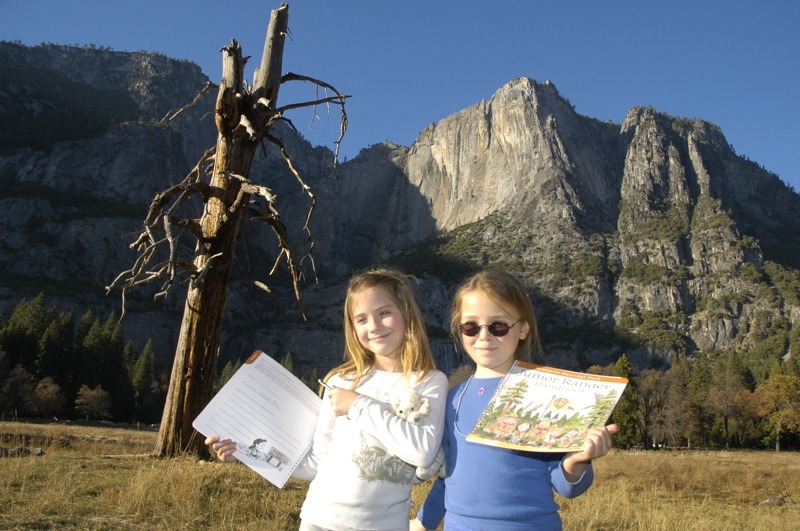
As I mentioned yesterday, Kelli and I are making a regular pilgrimage to the Ahwanee Hotel to borrow their wifi. There is a place in the hotel where you can sit on an overstuffed couch or chair and use your laptop in total comfort. After I had been there half an hour, the staff came over to light a fire in the giant stone fireplace, which warmed me nicely against the cool breeze floating in from the terrace.
The Ahwanee was built in 1927 as part of an effort to make America’s fledgling national park system more attractive to visitors. It’s a beautiful structure, with native American designs embossed in the concrete floors, hung on the walls, painted onto columns, and integrated in every aspect of the architecture. It’s old, rustic, and handsome without being rickety or overly fussy. I’d love to spend a couple of days there but the rooms start at about $385 a night. Our quiet spot half a mile away in the trees is $20 per night, which fits our budget better. Of course, we can’t schedule a masseuse and we have to ration our electricity, but we all see the same scenery.
Speaking of limited utilities, we decided that rather than rationing our water as severely as we did in Yellowstone, we’d live a little more luxuriously. Robert has a pair of 5-gallon buckets into which we can dump gray water. It’s a short walk to a graywater dump by the campground bathrooms, and it turns out that using the two buckets is a lot easier than the traditional “blue tank” in this particular setting.
But refilling our fresh water tank is a bit harder. I tried a 5-gallon flexible plastic water carrier that I bought at Wal-Mart, but it was a real pain, and the spout was too short. So after dark Robert and I hooked up all the water hose we both owned and strung together over 200 feet from the fresh water spigot all the way to our Airstreams. It was quite a production but after a few minor missteps we both ended up with full fresh water tanks and empty gray tanks (and no, we didn’t dump any on the ground). Thus we are set for another several days.
Is this the kind of adventure you want in Yosemite, or are you the type who would go for the Ahwanee every time? It’s a good question to ask oneself before emarking on the full-time life. Sometimes there are the awkward moments, like when I was carrying two sloshing buckets of gray water over to the dump. It’s up to you to decide if the compromises balance the rewards. For our part, we are staying in the Airstream.
October 25, 2007 at 9:14 pm · Filed under Maintenance, Travel / lifestyle musings
If you believe that all things must be scheduled and everything must fit the schedule, you may not be well suited for a full-time travel life. Likewise if your fear of the unexpected paralyzes you into inaction. To live this traveling lifestyle, I have found that we need to deal with changes in circumstance that arrive like snowflakes in January.
The brake actuator is a highly visible example but far from the only one. In the past two weeks we’ve probably had a dozen small unexpected changes to the itinerary due to weather, road closures, campground closures, mechanical problems, work considerations, and fuel prices. It’s all part of the game.
Today the news is not good. The actuator we have is a discontinued model. The replacement model is not a direct fit. It requires a new bracket and different wiring, and thus it should be installed by someone who knows something about the wiring of an Airstream. But the nearest Airstream dealer is George M Sutton RV in Eugene, about 150 miles away, which is too far for us to go without brakes.
None of the local service centers have ever seen this braking system before. The automotive shops don’t know 12v systems and the RV shops don’t know electric-hydraulic disc brake actuators. So we will have to find a way to telephonically transfer the knowledge of the original installers (Roger Williams Airstream in Weatherford TX) to the local RV shop. I’ve found a local company that is willing to attempt the task.
The other bad news is that the earliest we can get the replacement part is Monday. We were not planning to spend more than about 10 minutes here but it seems we will have plenty of opportunity to get to know the local area. We have three days to wait, and I don’t like to wait, so instead we will pretend we meant to stop in Warrenton and explore some of the local attractions.
Primarily this is the heart of Lewis and Clark country. There are no less than twelve historic sites related to the famous expedition, including the Washington state park we just left (Cape Disappointment) and the Oregon state park just up the road from here (Fort Stevens). We can’t visit them all in a three-day weekend, and Emma would go insane if I tried, but we can at least visit one or two.
There’s also a scenic drive down Rt 101 to Tillamook. We were going to do it with the Airstream, but with this delay it makes more sense to just go down for the day without the Airstream.
Just between you and me, however, I will admit that I really want to hitch up and go right now. I’d like to be at a beautiful beachside state park, which was the major goal of driving down Rt 101 through Oregon. I’d like to be heading relentlessly toward the warmer temperatures of California (even with the wildfires burning down in San Diego County). And as with last summer when the wheel came off the trailer, it’s hard to remain calm in the face of a mechanical problem that has no clear resolution at the moment. We can only trust that things will work out.
I think the Lewis and Clark historical sites will help with this. It will certainly put our current problem into perspective. Those guys in the Corps of Discovery basically floated, rode, and walked from what was (to them) the known world, into a completely foreign land of plants, animals, people, and incredible obstacles. They didn’t know when they’d be back, and they knew their chances of survival were unpredictable. The nearest analogue to that expedition today would be hopping in a space ship to Mars with a big pile of canned food.
So at those times when I feel like I’ve received a sentence to serve under “trailer arrest,” perhaps it will help to make a visit to the nearby site where the Corps stopped for a month to make salt. My worst food problem is finding a grocery that stocks those tasty maple cookies I like. Looking at it that way, things aren’t so bad after all.
October 18, 2007 at 10:11 pm · Filed under Travel / lifestyle musings
I was well warned that the Pacific Northwest would be gray and rainy this time of year, so the weather we’ve driven into is no surprise at all. It has been raining almost continuously since we arrived on Tuesday and the forecast says to expect no sunshine until Sunday at the earliest.
But that’s OK for now. We are parked here to catch up on work and do a little planning for the future, not to play on the beach. This sort of pause in the action is a part of the full-time experience. We can’t take our next week for granted. We’ll wake up in the same bed for sure, but where will it be?
From the outside looking in, some people may assume we have a grandiose Master Plan which directs us. Others wonder, asking us, “How do you decide where to go?” The truth is that we have only the vaguest of Master Plans, and it is driven by basic influences, like the seasons. As I mentioned a couple of days ago, in the winter we have to stay south and below 6,000 feet. In the summer we head north and go visit family. Other than that, we consider things like upcoming holidays, business meetings, rallies, or interesting sights guide us. The school schedule is no longer an immediate factor since we plan to keep homeschooling for second grade.
For now, the season forces us west of the mountains, hugging the mild coast until we get into southern Oregon. We can only go south from here, and so that’s the plan: stay low and head south. But then there are details to work out. Thanksgiving is coming. Where will we spend it? We’ll need a full hookup for the actual day, since Eleanor will be doing massive cooking. I’ve been collecting ideas and talking to friends that we might meet.
Another example: I need to meet some people in California for future articles and business meetings. When will we be there, and where will we want to camp near major metros like San Francisco and Los Angeles?
And then there are the places we want to visit simply for the sake of visiting. Yosemite will be at the tail end of the season, but we might sneak in for a couple of nights. I’ve been wanting to have dim sum with Larry and Bill in San Diego. We’ve got friends in Oregon and California to catch up with. And we definitely want to spend a week or more in Anza Borrego.
We toss all these ideas, obligations, and wishes into a mental bag and let them all rattle around. Pauses like the one we have had over the past two days give us a chance to look inside the bag and put everything in order.
Practically speaking, it’s also a chance to spend a lot of time online researching. Sometimes you’ve just gotta surf for a few hours to figure out what’s ahead. Parks, campgrounds, scenery, weather, events, postal drops … all the info is out there if you go hunt it up. I make notes on alternative ideas, tell the Post Office where to forward our mail, and then hope for the best.
So we’ve done that and now I’m sick of the endless rain and sitting inside the trailer. On the San Juan Islands the forecast was for rain and 30-40 MPH winds with gusts to 60 MPH, so we stayed put. But tomorrow we are moving. I have the feeling that if I wait for a nice sunny day to tow we might be here all winter.
« Previous entries ·
Next entries »
 Around 10 this morning we had a visit from Shaun Kieran and his associate Nikolai, who work repairing church organs all over southern and central California. They pulled up in a new 20-foot Airstream Safari Special Edition, which they live in while working on jobs. On the weekends, Shaun brings his wife and two small children out in the Airstream for vacations.
Around 10 this morning we had a visit from Shaun Kieran and his associate Nikolai, who work repairing church organs all over southern and central California. They pulled up in a new 20-foot Airstream Safari Special Edition, which they live in while working on jobs. On the weekends, Shaun brings his wife and two small children out in the Airstream for vacations.









